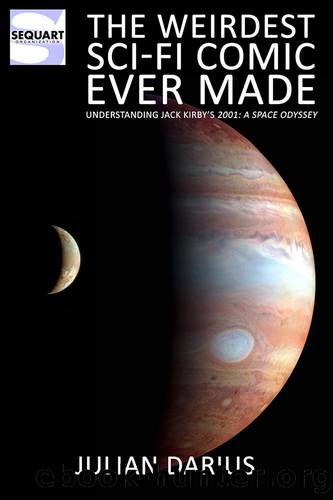The Weirdest Sci-Fi Comic Ever Made: Understanding Jack Kirby's 2001: A Space Odyssey by Darius Julian

Author:Darius, Julian
Language: eng
Format: epub
Publisher: Sequart Organization
Published: 2013-05-25T00:00:00+00:00
Kirby deconstructs the expectations of the super-hero genre with comedic brutality. From 2001, A Space Odyssey #5 (Apr 1977). Art by Jack Kirby and Mike Royer.
Throughout the 1970s, Kirby had launched offbeat title after offbeat title, both for DC and for Marvel, only to see them cancelled â usually with surprising rapidity. Meanwhile, the titles he co-created with Stan Lee in the 1960s kept right on selling. Kirbyâs criticism of how fans regard âthe slightest deviationâ as âan emotional traumaâ certainly reads like a complaint about the inflexibility of the American comics reader (which, incidentally, didnât end in the 1970s). The word âbelieverâ also recalls how Stan Lee, in his letters columns and editorial captions, routinely called Marvelâs readers âtrue believers.â Kirbyâs doing something remarkably transgressive here â in a comic published by Marvel, no less.
Kirbyâs career stretched from the 1940s (the so-called Golden Age of comics) into the 1980s. For the first couple decades of his comics work, comics werenât so dominated by the super-hero genre. Adventure, crime, detective, and romance stories were sometimes as, or more, popular than super-heroes. While we often look at fanzines and comics conventions as positive developments, since they give readers power and even allow them to participate in comics culture (and played a major role in the study and promotion of comics history), Kirby may be connecting these developments with the codification of comics readers and their expectations. Instead of comics readers being decentralized in local pockets, fanzines and comics conventions helped create a common culture. And with this culture, Kirbyâs references to fandom suggest, came a kind of petrification of the super-hero genre â so extreme that âthe slightest deviationâ leads to âemotional trauma.â
Itâs notable that what breaks the illusion for White Zero isnât the villains, or the explosive threat, or the deathtraps â all of which accord with genre expectations. The only thing thatâs âwrongâ is that the princess doesnât fit the unrealistic, gorgeous body type expected of a love interest. Compared to the structure of a super-hero story, the love interestâs body type ought to be the most trivial thing. Perhaps thatâs Kirbyâs point, underlining how narrow the super-hero readerâs allowance for deviation is. But as weâve noted, Kirby was known for his relative inability to draw attractive women, so perhaps his choice of âslightest deviationâ is a more personal gripe against his readersâ expectations. Should we wish, however, we may also see this as a feminist argument, pointing out how staunchly comics readers seem to expect unrealistic female bodies. In recent years, the internet has revealed just how strongly some fans feel about this issue, and few topics seem to provoke reactionary zeal among super-hero fans as complaints about the depictions of women. In this context, White Zeroâs reaction to the princessâs body doesnât seem exaggerated at all. (Neither, some would say, does his name.)
When White Zero exits through the waiting room, heâs chided by the other costumed customers, which he returns in kind, telling them to âgrow up!â
Download
This site does not store any files on its server. We only index and link to content provided by other sites. Please contact the content providers to delete copyright contents if any and email us, we'll remove relevant links or contents immediately.
Machine Learning at Scale with H2O by Gregory Keys | David Whiting(4083)
Fairy Tale by Stephen King(3192)
Zero at the Bone by Jane Seville(2990)
The Man Who Died Twice by Richard Osman(2977)
Oathbringer (The Stormlight Archive, Book 3) by Brandon Sanderson(2832)
Will by Will Smith(2766)
The Stranger in the Lifeboat by Mitch Albom(2029)
Principles for Dealing With the Changing World Order: Why Nations Succeed and Fail by Ray Dalio(1951)
The Complete Witcher by Andrzej Sapkowski(1773)
Cytonic by Brandon Sanderson(1746)
A Short History of War by Jeremy Black(1741)
Go Tell the Bees That I Am Gone by Diana Gabaldon(1666)
Leviathan Falls (The Expanse Book 9) by James S. A. Corey(1626)
Strange Weather in Tokyo by Hiromi Kawakami(1588)
515945210 by Unknown(1581)
A Game of Thrones (The Illustrated Edition) by George R. R. Martin(1558)
Flight by Elephant(1469)
443319537 by Unknown(1448)
The Last Graduate by Naomi Novik(1443)
